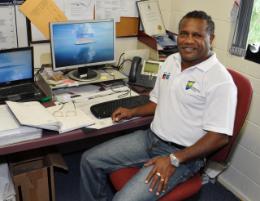Strength in diversity
Published on 09 April, 2010
Wayne Ah-Wong's research reveals how three different ethnic groups retained their cultures, and changed, as they encountered Australia's white colonial system, writes Amanda Woodard in CQUniversity's research magazine, LINK..
Oral history offers a vital window on our past that, with the passing of a generation, becomes the stuff of history books. With that in mind, 55-year-old Wayne Ah-Wong, whose family includes Aborigines, Torres Strait Islanders and South Sea Islanders, drew on his relatives' accounts in unique research that revealed how these ethnic groups have interrelated from the 1930s to the present day.
 Ah-Wong, the Recruitment & Retention officer at Nulloo Yumbah, CQUniversity's Indigenous Learning, Spirituality & Research Centre, says these ethnic groups are often lumped together. "We often hear Aborigines called ‘blackfellas' when there are different groups all around the country; or people from Torres Strait and the South Seas just called ‘islanders'. "
Ah-Wong, the Recruitment & Retention officer at Nulloo Yumbah, CQUniversity's Indigenous Learning, Spirituality & Research Centre, says these ethnic groups are often lumped together. "We often hear Aborigines called ‘blackfellas' when there are different groups all around the country; or people from Torres Strait and the South Seas just called ‘islanders'. "
Ah-Wong grew up in Mackay, a region that has historically had a large population of Torres Strait and South Sea Islanders and Aboriginal people. In Mackay, Ah-Wong approached three respected elders from each ethnic group - all men were in their seventies and were related to him either through marriage or extended family. "These were men who had taken leadership roles in politics or in their workplace and spoken up for their people in the past," says Ah-Wong.
During a series of interviews, Ah-Wong asked them to recall and reflect not only on their personal histories - childhood, education, employment, war service - but their perspective on what was going on in their wider communities. In doing so, he wanted to find out how the lives of Aborigines, South Sea Islanders and Torres Strait Islanders interacted and how their experiences of life differed adapting to a white colonial system.
The elders spoke about the changing social, cultural and economic status of each group, such as when South Sea Islanders were brought to Queensland as indentured labour during the 1800s to service the sugar industry. Although they were allowed greater freedom of movement to find work than Aboriginal people, who were routinely moved onto reserves, South Sea Islanders weren't entitled to the same social services as the other two indigenous groups. Aboriginal people, on the other hand, suffered greater oppression, having their language suppressed, unlike Torres Strait Islanders. In the case of South Sea Islanders, many appeared to voluntarily suspend their own language on arrival in Australia.
What emerges beyond the colonial rule and oppression is a multi-layered story of intermarriage and absorption of aspects of each other's culture - particularly in the case of Aborigines for whom it wasn't beneficial to be identified as such. "Most Aborigines became invisible by marrying South Sea Islanders. Now they're starting to reintroduce and reinvigorate their culture through language and dance," he says. The Torres Strait Islanders retained some of their traditions, such as tombstone openings, and while South Sea Islanders lost a lot of their culture some things have not been forgotten. Ah-Wong was told that "when one lady went back to her island, she was identified by the song she sang".

